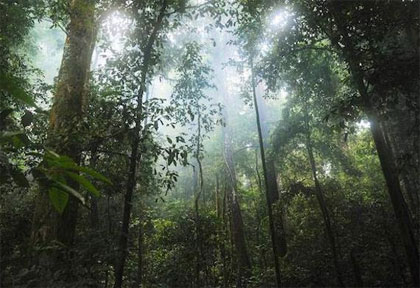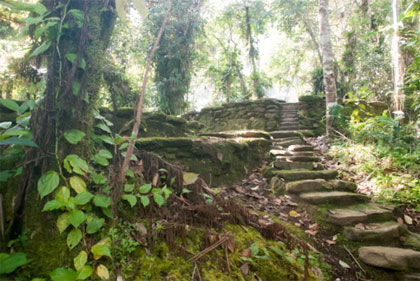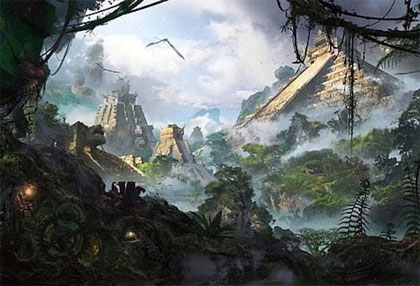
The Strange Case of the Cursed Lost City of the Monkey God
Bizarre
historical oddities
lost cities
modern mysteries
There have always been those places that have remained out on the fringes, those legendary locations that seem to be forever beyond our reach out over the horizon. Tales of lost cities and civilizations have always perplexed us, existing out past the boundaries of our civilization in the remotest wilds of our world. Explorers have long sought such places out, and it seems that sometimes they succeed. One such place is a supposed cursed jungle city, lost for ages but then found, only to prove that perhaps the curse is not just merely a legend after all.
Sprawled out over 20,000 square miles of Honduras and Nicaragua is a vast sprawl of thick rainforest called the La Mosquitia jungle. It is a harsh and forbidding place, full of dangerous insects and animals, a nearly impenetrable wall of jungle beyond civilization like some sort of lost world. It was here in this unforgiving place that there once existed a legendary city that the Spanish conquistadors called La Ciudad Blanca, or “The White City,” known to the indigenous tribes as “The Lost City Of The Monkey God” because it was said to contain a giant buried statue of a monkey god. It was said to be a place of unimaginable riches, full of gold and silver, but also one with the dark cloud of a curse hanging over it. According to the legends of the area, at some point in the 16th century the people of this city suddenly abandoned it without warning, saying it was cursed with pestilence and disease by the wrathful gods, and after that it was left to be swallowed by the jungle. Stories swirled about this fantastical city and its curse, tales abounding of those who went and tried to find it but never came back, and for a long time it was another spooky, Indiana-Jones style story of a lost city in the jungle forgotten by the world.
Many explorers ventured out into the wilds to search for the White City without success, and for the most part it remained mostly thought of as nothing more than mere legend, another lost city forever beyond our reach and confined to mere myth and speculation. It would not be until 1940 that explorer Theodore Morde would discover the 1,500-year-old ruins of an ancient city with high walls of white stone, sacrificial chambers, a pyramid, and a massive stone statue of a monkey, and he would proclaim that he had successfully located the lost White City. As proof he brought back thousands of artifacts from the site, but fearing that other explorers would ruin the find or that there would be those who would plunder it, Morde kept the location a secret, taking its exact location to the grave with him upon his death and once again flinging the White City into the realm of myth and legend.
 In 2012, explorer Steve Elkins, decided to carry out his own search for the lost city. Elkins had been obsessed with the Lost City of the Monkey God since the 1990s, meticulously reading and studying whatever he could find about it. In this case, he was armed with cutting edge LIDAR technology, which stands for “laser imaging, detection and ranging,” which is a kind of laser imaging system that can create high resolution 3-D maps of an area even under the canopy of trees. The system is highly efficient, able to scan hundreds of square miles of dense jungle in a matter of days. Elkins performed a privately funded aerial LIDAR survey and managed to find what looked like rectangular structures, including two perfectly linear lines, and a right angle, meaning these were most likely manmade constructions. Elkins would say of the finding:
In 2012, explorer Steve Elkins, decided to carry out his own search for the lost city. Elkins had been obsessed with the Lost City of the Monkey God since the 1990s, meticulously reading and studying whatever he could find about it. In this case, he was armed with cutting edge LIDAR technology, which stands for “laser imaging, detection and ranging,” which is a kind of laser imaging system that can create high resolution 3-D maps of an area even under the canopy of trees. The system is highly efficient, able to scan hundreds of square miles of dense jungle in a matter of days. Elkins performed a privately funded aerial LIDAR survey and managed to find what looked like rectangular structures, including two perfectly linear lines, and a right angle, meaning these were most likely manmade constructions. Elkins would say of the finding:
They were either man-made or the world’s most intelligent gophers were out there, doing things they’d never done before. I knew we found a city, an ancient city. That I knew. But what it was, beyond that, that was up to the archeologists to figure out.
Elkins immediately started meticulously planning for a ground expedition to go into that uncharted jungle and try to confirm what had been seen from the air. To this effect he had National Geographic artists come up with a rendering of what the city might have looked like, made careful maps of the area, and gathered together a joint Honduran-American expedition that included documentary filmmaker Bill Benenson, the world-famous author and explorer Douglas Preston, and a team of archaeologists, anthropologists, engineers, geologists, biologists and ethnobotanists, and even a team of British ex-S.A.S. jungle warfare specialists to protect them from hostile locals in a lawless region controlled by drug cartels and train them for the ordeal ahead. After three long years of planning, in 2015 the team was ready to go, but it would be a formidable challenge due to the harsh terrain, dangerous animals, and unfriendly locals. Preston would describe what they faced ahead of them:
Geography — natural and human — has everything to do with why the city remained undiscovered. In this area, some of the thickest rain forest on Earth covers precipitous mountain chains, some over a mile high, with roaring torrents, frequent landslides, steep ravines, waterfalls, pools of quick mud that will swallow a person alive, and noxious insects carrying diseases. The understory is infested with deadly snakes, jaguars, and thickets of catclaw vines with hooked thorns that tear at flesh and clothing. In Mosquitia, an experienced group of explorers, well equipped with machetes and saws, can expect to journey two to three miles in a brutal 10-hour day. The towns and rural areas surrounding the jungle are largely controlled by drug cartels, with a murder rate that is the highest in the world. The fierce physical terrain, combined with surrounding lawlessness and violence, have protected this area for centuries.
 Many of the team had little to no experience in the jungle, so precautions and safety were the order of the day. No outsider had been into that jungle looking for the city sing the 1940s, so they had no idea what to really expect. The jungle warfare specialists tried to get them up to speed on what it would be like once they hit the ground, but for many it seemed too surreal to even imagine. Preston has said of it:
Many of the team had little to no experience in the jungle, so precautions and safety were the order of the day. No outsider had been into that jungle looking for the city sing the 1940s, so they had no idea what to really expect. The jungle warfare specialists tried to get them up to speed on what it would be like once they hit the ground, but for many it seemed too surreal to even imagine. Preston has said of it:
We flew in on helicopters and we had a team of three British ex-S.A.S. jungle warfare specialist soldiers with us whose job it was to keep us alive. I’ll never forget them giving us this lecture about the dangers of the jungle and the diseases, the poisonous snakes, the animals that we might encounter, the insects, the scorpions, the spiders, the ants that bite you and require hospitalization, and on and on. I just thought they were exaggerating the hostility of the jungle for the benefit of people who aren’t experienced in wilderness travel, which I was. So I kind of dismissed it all as exaggeration. When we arrived there by helicopter it was a beautiful sunny day, there were no insects, the temperature was a balmy 75 degrees. I looked around thinking, “What a bunch of hogwash about how dangerous this jungle is.” Yeah, this is paradise. I mean, there were flowers, there were beautiful bird of paradise flowers everywhere. The trees were gigantic. Some of the trees had trunks that were 20 feet in diameter. The animals, apparently, had never seen people before, they just wandered up to us. Then the insects came out at night, absolute clouds of them. I found myself getting into my sleeping bag completely covered with crawling insects. It freaked me out. I thought, “Well, maybe this area is all that they described it as.”
That night he would get his first true wake-up call to the reality of the situation when a dangerous Fer-de-Lance snake made its way into camp that was so close to Preston and so agitated that one of the jungle specialists had to be called in to kil it. Preston says of what happened:
It was pitch dark. In the jungle at night it’s just so dark, it’s like being in a cave. I was walking back to my hammock and my flashlight fell on a giant Fer-de-Lance snake, which is the most venomous snake in the New World. It was coiled up, very aroused, in striking position, tracking me. I’d walked by the snake twice! So I called out. Now, I think I kept my voice calm, but they claim I was yelling. I said, “Hey, you guys, there’s a really big snake here.” And Woody, who was the chief logistics expert of the expedition, said, “Oh my god, it’s a Fer-de-Lance! It’s one of the biggest I’ve ever seen! I’m going to move it.” I thought, “How is he going to move that snake? That’s crazy.
He cut a snake stick – it was about seven feet long – and with one fast movement, he pinned the snake with the forked end of the stick. At that point, the snake exploded in a fury of striking this way and that way, expelling venom in the air — arcs of venom flying through the air. I mean, I’ve never seen anything like it. This thing had fangs that were more than an inch long and it was bigger than he was! He managed to work the stick behind the snake’s head, then he grabbed it behind the head. But the snake was twisting its head around trying to sink its fangs into the back of his hand. It expelled venom all over the back of his hand and his skin was starting to bubble. He wrestled the snake to the ground, which was really difficult. This snake was longer than he was, and he had to pin it with his knees while holding its head. Then he cut off its head. The decapitated head continued to snap and spew venom, while the headless snake continued to fight and then tried to crawl off. I have never in my life seen a scene as horrific as this. It was like something out of a horror film.
 For several days the team moved out into the jungle, dodging venomous snakes, hostile natives, and drug cartels, swatting away biting ants and mosquitos, and avoiding holes of quick mud that could swallow a person whole and almost claimed the life of one of the team members. The jungle was so intense, relentless and aggressive that progress was extremely slow, and from ground level the trees and underbrush were so thick that at times it seemed to them as if they could be standing right on top of the ruins and not even know it. They even began to doubt that there was anything there at all, but then they stumbled across the remnants of stone structures just barely jutting up through the forest undergrowth, and as they continued more and more structures bloomed out of the jungle to greet them. They had finally found what they had spent years working towards, and The Lost City of the Monkey God had once again leapt from legend into reality. Preston would explain of his first thoughts upon finding this long forgotten relic:
For several days the team moved out into the jungle, dodging venomous snakes, hostile natives, and drug cartels, swatting away biting ants and mosquitos, and avoiding holes of quick mud that could swallow a person whole and almost claimed the life of one of the team members. The jungle was so intense, relentless and aggressive that progress was extremely slow, and from ground level the trees and underbrush were so thick that at times it seemed to them as if they could be standing right on top of the ruins and not even know it. They even began to doubt that there was anything there at all, but then they stumbled across the remnants of stone structures just barely jutting up through the forest undergrowth, and as they continued more and more structures bloomed out of the jungle to greet them. They had finally found what they had spent years working towards, and The Lost City of the Monkey God had once again leapt from legend into reality. Preston would explain of his first thoughts upon finding this long forgotten relic:
It is incredible to think that a lost city could still be found in the 21st century, but that is precisely what happened. People feel the world has shrunk. We have trodden upon, mapped, photographed, and exploited every place on Earth to the point where it feels like we’ve robbed the world of its mystery. But this discovery puts some of that mystery back. It proves we don’t know everything, and it shows us there are still places on Earth that are indifferent, hostile, or even inimical, to human beings. Mosquitia is one such place.
I can recall the very moment when we stumbled over the cache of sculptures at the base of an earthen pyramid. I first saw a carved jaguar head coming out of the ground. Gleaming with rain, it rose up snarling, as if struggling to escape the earth. It was an image that spoke directly to me across the centuries — forging an immediate, emotional connection to these vanished people. What had been theoretical for me became real: this spirited image had been created by people who were confident, accomplished, and formidable. Standing in the gloom among the ancient mounds, enveloped in the mist, I could almost feel the presence of the invisible dead.
They would soon document plazas, terracing, canals, roads, and earthen structures, including a pyramid. It was apparent that more than stone and earthen structures had once been there, but they were all that remained in the hostile acidic jungle conditions. The residences would have been made of adobe, wood, and other perishable materials that would not have lasted long when the city reverted to a feral state choked by trees and undergrowth. However, what did remain was pristine and had not been looted, yielding a treasure trove of pottery, sculptures, eating utensils, weapons, decorated cylindrical stone vessels, and various other artifacts that had been left behind by the people who had so mysteriously abandoned the city. Preston explains of some these amazing discoveries:
The most spectacular discovery was the cache of sculptures found at the base of a pyramid. In a broad hollow area, just poking out of the ground, we came across the tops of dozens of extraordinary carved stone sculptures — 52 in all. The objects, glimpsed among leaves and vines, and carpeted with moss, took shape in the forest twilight: the jaguar head mentioned above, great stone jars carved with vultures, snakes and monkeys, objects that looked like thrones or tables, many with carvings along the rims and legs. These sculptures were in beautiful condition and had probably been lying undisturbed since they had been left centuries ago — until we stumbled across them.
Excavation of the cache revealed it was vast: over 500 sculptures and fragments, with many more still buried as of this writing. They had all been left at the same time when the city was abandoned, many ritually broken to release their spirits, a common practice for objects placed in a grave. But this cache was not the grave of a person — it was the grave of the entire city. Archaeologists theorize that a mysterious a catastrophe struck the city, killing most of the inhabitants. The survivors gathered up all their sacred objects, placed them as an offering to their gods, and walked away — never to return.
 It was an incredible archeological discovery, but it seems that they had not only uncovered the Lost City of the Monkey God, but also its sinister legendary curse, when two-thirds of the expedition- Hondurans, Americans and Brits alike- came down with a deadly flesh-eating disease called leishmaniasis. The disease causes giant weeping sores and can lead to death if not treated properly, and Preston has explained that it seemed to be so prevalent in the area that it was likely why the city had been abandoned in the first place. He has said of their ordeal with the rampaging disease:
It was an incredible archeological discovery, but it seems that they had not only uncovered the Lost City of the Monkey God, but also its sinister legendary curse, when two-thirds of the expedition- Hondurans, Americans and Brits alike- came down with a deadly flesh-eating disease called leishmaniasis. The disease causes giant weeping sores and can lead to death if not treated properly, and Preston has explained that it seemed to be so prevalent in the area that it was likely why the city had been abandoned in the first place. He has said of their ordeal with the rampaging disease:
We came down with this disease called leishmaniasis, a very bad form of it called mucocutaneous leishmaniasis. It’s essentially a flesh-eating disease. It’s like leprosy and it’s transmitted by the bite of a sandfly. But the parasites — it’s a single celled animal — migrate to your face and they eat away your nose and your lips until they fall off and leave your face an open weeping sore. And then they eat away the bones of your face and create a hole in your head, and eventually, you die. Now, that happens if you’re not treated. We got treated. It’s a really horrible treatment. It doesn’t cure the disease but at least it beats it back. So we’re okay, but it was pretty rough on some people. In fact, the Honduran archaeologist nearly died of it. It has returned in a number of people. But we are getting the best medical care in the world from doctors at the National Institutes of Health, who are studying us and our disease, which appears to be a unique form. It makes for a fascinating medical mystery.
He also fears that the presence of this disease will combine with the treacherous locale to hinder any further future exploration of the lost city. Preston laments on the issue:
It’s just too dangerous. And just getting in and out is dangerous. I think it’s going to take a long time. In fact, it may never be entirely explored because it turns out the valley was a hot zone of disease that affected almost everyone on the expedition. It’s a very dangerous and incurable tropical disease, which has really limited the ability of archaeologists to work there because they get sick.
Preston has gone on to write a best-selling book on history of the lost city and his own expedition, called The Lost City of the Monkey God: A True Story, and the case has managed to stir up a mixture of excitement and controversy. While it is undeniably an amazing discovery, some locals have accused the explorers of disturbing a sacred site, and there are also archeologists that have rolled their eyes at what they see as more of a lurid, Indiana-Jones style action story than any real science. In the meantime, Preston and his crew have not been back to the city, and it still remains almost completely unexplored. It seems to be a place that actively shuns human presence, a place that does not want us there, and perhaps it will always remain shrouded in mystery and beyond our understanding.
MU*


















